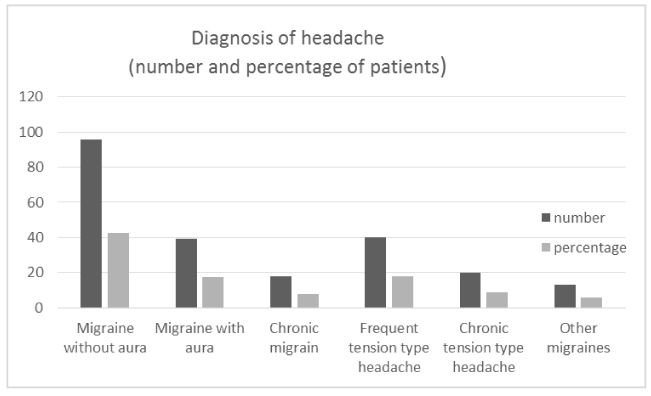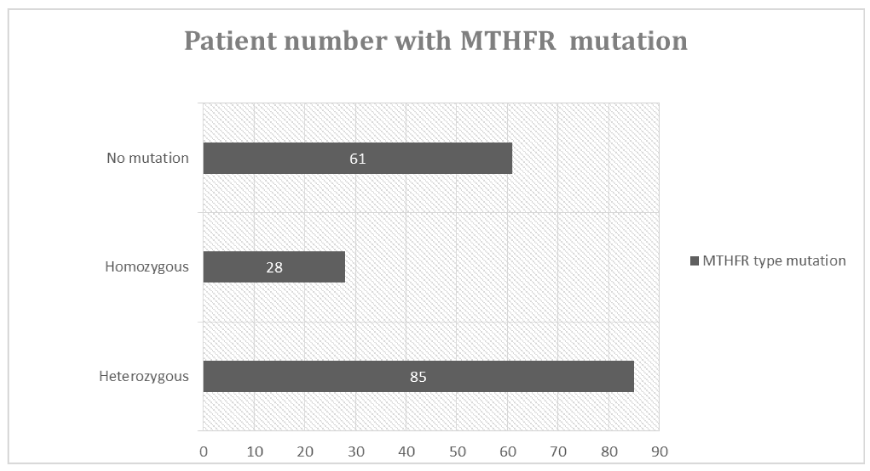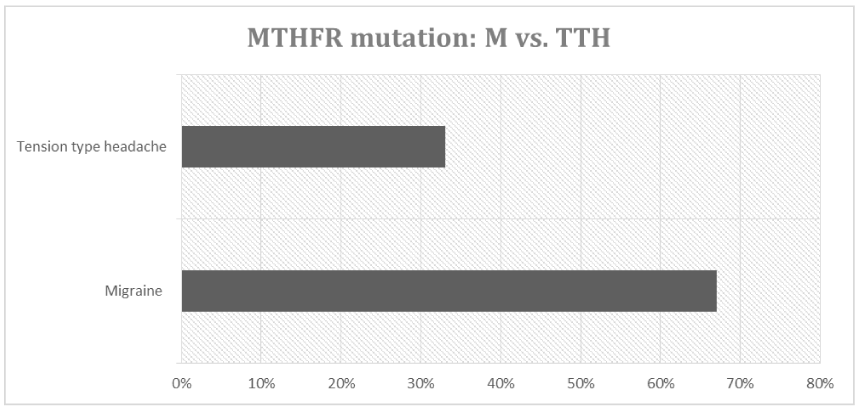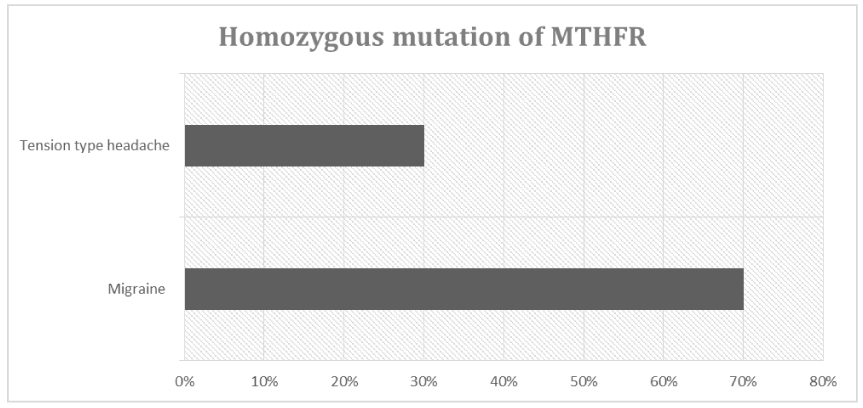The Methylenetetrahydrofolate Reductase and Polymorphism C677T in the Children with Headache?
Elisabetta Tozzi*, Alessandra Piccorossi, Cristina Gammella, Agnese Onofri, Alberto Verrotti and Enzo Sechi
Neuropsychiatric clinic, Pediatric Clinic, Headache center of region Abruzzo- Hospital San Salvatore, University of L’Aquila Department of Medicine, life and environmental science (MESVA), Italy
*Address for Correspondence: Elisabetta Tozzi, Headache center Hospital San Salvatore, Department of Medicine, life and environmental science University L’Aquila, Italy, Tel: +0039-0862-368240; Email: [email protected]
Submitted: 28 August 2017; Approved: 05 September 2017; Published: 07 September 2017
Citation this article: Tozzi E, Piccorossi A, Gammella C, Onofri A, Verrotti A, et al. The Methylenetetrahydrofolate Reductase (Mthfr) Gene Polymorphism C677t and the Migraine: Evaluation of a Children Sample. Int J Neurol Dis. 2017;1(1): 028-032.
Copyright: © 2017 Tozzi E, et al. This is an open access article distributed under the Creative Commons Attribution License, which permits unrestricted use, distribution, and reproduction in any medium, provided the original work is properly cited
Keywords: Migraine; Children; Homocysteine
Download Fulltext PDF
Background: The headaches are a heterogeneous clinical manifestations characterized not only by pain but also by a severe multifactorial disabilities, often associated with other comorbidities that severely affects the patient’s quality of life. And ‘it is known for some time the risk of cerebrovascular disease in migraine patients. Numerous studies showed the association between the enzyme MTHFR mutations , the T allele and genotype TTand migraine, particularly migraine with aura.
Aim of the study: On the basis of theliterature data we propose to evaluate the prevalence of the MTHFR mutation in the population of patients admitted to a headache center of the childhood.
Materials and methods: Weexamined 226 children, aged 5-17 years,admitted to “Headache Center” of Children Neuropsychiatry of Hospital San Salvatore L’Aquila, from 2013 to the year 2015. The diagnosis of headache are made according toICHD III criteria. The identification of the MTHFR C677T polymorphism of the enzyme was carried out by the Real-time PCR qualitative. The statistical analysis by SAS System.
Results: Diagnosis of migraine without aura in 96 patients, migraine with aura in 39, in 18 chronic migraine, Frequent episodic tension-type headache in 40, chronic tension type headache in 20 and in 13 other headaches. 61 patients are without mutation, 85 with heterozygous mutation, and 28 homozygous. Therefore, the mutation is present in 147 patients with a percentage of 65%. The heterozygous mutation is present in 50.56% of females and 47.06% males; the homozygous in 10.19% and 12.94% in females than males. In migraineurs the mutation is present in 66.67% compared with patients with tension-type headache (33.33%), homozygous is the 70.37% versus 29.63% (p <0.001). Homocysteine levels are elevated only nell’8.69% of mutated patients, of which 5/12 patients have a mutation in homozygosity.
Conclusions: We confirme the statistical association between MTHFR mutationboth in the heterozygous and homozygous forms and migraines.The migraines with aura, unlike the literature, does not seem to have a important role. Also the homocysteine not seems statistically affect the trends of the forms of headaches examined.
Introduction
Migraine is a common debilitating disorder associated with multiple symptoms and not only with the pain. The migraines are on a chapter of “The International Headache Society classification, 2013 version” [1] and were considered two different categories: migraine with aura (MA) and migraine without aura (MO).The MA has been related to Methylenetetrahydrofolate Reductase (MTHFR) gene mutation and high levels of Homocystein (Hcy) [2-8] Hcy is a product of methionine metabolism and is a sulfur-containing amino acid [2-4] MTHFR is an enzyme responsible for the conversion of Hcy to methionine and it catalyzes the reduction of 5,10-methylenetetrahydrofolate (CH2-THF) to 5-methylenetetrahydrofolate [4]. If Hcy is not properly metabolized, its high levels could be associated with vascular damage and endothelial re modeling, this condition could be responsible of a reduction in blood oxygenation in brain circulation close to onset and maintenance of migraine attacks [5,6] The polymorphism most frequently identified is C677T and it is related not only to migraine, but also to other neurological/ psychiatric and organic symptoms as neural tube defects, cerebrovascular and cardiovascular disease, hypertension, glaucoma. Among neurological and psychiatric disorders that are associated with migraine, depression, anxiety disorders, epilepsy and sleep disorders are reported. More recently, an association with cardiovascular disease has been highlighted, particularly with ischemic stroke [4-7]. C677T polymorphism is characterized by a substitution of an alanine with avaline at position 222; this substitution leads to a reduction on enzyme activity [6]. Subjects with the C677T variant present reduced capacity to remethylate Homocystein to methionine, these conditions increase Homocystein plasma levels [6,8].
Objective of study
Aim of the study was the evaluation of one MTHFR gene mutation in a group of patients suffering from primary headache.
Materials and Methods
The study population wass enrolled in the Department of Neuropsychiatric affering to Regional Headache Center of Region Abruzzi, University of L’Aquila. The patients were recruited according to temporal criteria by observations sequentially during the years 2015 and 2016.The children are born in Italy from parents italians.The diagnosis of headache was made according to ICHD-III criteria [1]. The sample of study consists of 226 patients, 116 females and 110 males, aged between 11 to 13 years. Whole blood samples were collected using EDTA tubes and transferred in an upright position to local lab, where were stored at -20°C to freezer. During patient diagnostic evaluation we detected C677T variant of Metylenetetrahydrofolate reductase based on the Real-Time Polymerase Chain Reaction (RT- PCR), we considered the homozygous and heterozygous T alleles of variant. The polymorphism C677T was identified using SAMPLE PREP thrombo kit (Diatec Pharmacogenetics), using a TAQman probe and a melting analysis to determinate genotypes [9]. The total Homocystein (tHcY) was determinate using a achemiluminescent immunoenzymatic assay (CMIA) Homocystein Architect [10].
Statistical analysis
The statistical analysis was conducted by SAS system. The MTHFR polymorphism and tHcY levels were analyzed by χ2 test. The results were considered statistically significant when p ≤ 0, 05.
Results
In the (Figure 1) we show the diagnoses of primary headache and relative percentages of total sample.96 patients suffering from Migraine without Aura (MwA), 39 from Migraine with aura (MA), 40 from Tension Type Headache (TTH), 18 from Chronic TTH,13 from chronic Migraine, 12 from other migraine. The C677T variant of MTHFR was detected in 147 patients (65%) (Figure 2). The heterozygosis was present in the 50, 56% of females and 47, 06% of males, whereas the homozygosis 19, 10% of females and 12, 94% of males respectively. On the basis of headache diagnosis, in all migraineurs, the mutation was present in 88 children (67%) compared to tension type patients in which was in 19 children (33%) (χ2 18, 9, p < 0, 0001) (Figure 3). Homozygosis was identified in a rate of 70% for migraineurs (103 pt) and 30% of patients with tension type headache (17 pt) (Figure 4). Also this comparison resulted statistically significant (p = 0, 0030). In 19 children (8.67%) we found increased levels of tHcY. The results of statistical analysis of tHcY levels (µmo/l) are in (table 1).
Discussion
Our results confirmed available data of literature. In fact, in present study, population migraineurs had higher prevalence of MTHFR mutation, especially in homozygous with respect to Tension type headache. The data of Italy population show mutation in homozygous in 8, 8-10% of people [12].
According to Lea [2] and other several Authors, [6,11] C677T MTHFR variant predisposes to a susceptibility to migraine with aura and not to that without aura, in particular, it is well- known for European Caucasian population. A meta-analysis of 15 case control studies showed a close correlation between TT variant and Caucasians suffering from MA, in non Caucasian population this genotype is associated with total migraine [11].
In a study of Bottini et al. was analyzed the prevalence of homozygous variant of an Italian study population, it was identified a trend towards an increased incidence of migraine in subjects who carried the mutation [8], another study examined a group of Croatian pediatric patients suffering from migraine, the 677TT genotype was associated with an higher risk of migraine [11]. No association was found in Spanish and Portuguese adult migraineurs [13,14]. Lorenz et al. analyzed MTHFR 677TT polymorphism in a group of Estonian pediatric migraineurs and did not detect a close link with migraine prevalence [14]. So MTHFR C677T variant differently occur in different countries [15]. In the pathogenesis of aura migraine is hereby accepted the concept of “Cortical Spreading Depression” (CSD), in the aura phase there is a cerebral oligoemia that starts to spread anteriorly and a condition of hyperemia follows to this [16,17]. It is known that about 37%of migraineurs presents white matter abnormalities, predominantly in the posterior circulation and in cerebella territory; some case studies show a prevalence of these lesions (61%) in people with aura migraine and female [18]. Among the causes of such anomalies, in addition to the patent foramen ovale, high blood pressure and other risk factors for stroke, such as cigarette smoking, use of oral contraceptives, obesity, hypercholesterolemia, there is the MTHFR C677T mutation. An elevated plasma vWF activity is associated with MTHFR TT genotypes, so it represents a connection between migraine and ischemic predisposition [13,18]. In our study Hcy levels were normal in a greatest percentage of patients. Plasma tHcY is present only in homozygous variant and only in 19 children .These results are partially in contrast with available data in literature. A case study conducted in pediatric patients suffering from stroke, confirms the presence of hyper homocysteinemia among the causal factors of stroke [19-21]. According to recent publications, migraine headache, especially those with aura, however, it could be conceived as the pathological mediator between the mutation and the phenotypic outcome of stroke [11,13]. In a study of Lea et al. on 52 patients suffering from aura migraine with increased levels of Homocystein, it was administered to patient’s vitamin supplementation, as Homocystein levels decreased frequency and severity of migraine attacks declined [22]. In the trial of Di Rosa et al. on 16 children with MA and high levels of Homocystein the folic acid supplementation, induced the reduction of migraine attacks in 6 children and in 10 patients did not occur migraine attacks [23]. High levels of Homocystein are associated with vascular and endothelial damage and with cerebrovascular and cardiovascular disease; in particular, it has been assumed that hyperhomocysteinemia is involved in reducing brain blood flow and producing the depolarization wave defined as CSD. These facts associated with reduced oxygen transfer could act as trigger of migraine attack. The endothelial damage induced by high levels of Homocystein could decrease nitric oxide release and leads to the initiation and maintenance of migraine attacks [24].
Conclusions
In our study the frequency of migraine (158 pt) is higher than that of tension headache (58 pt) (71.83% versus 28.17%), in particular, the percentage of mutated migraine patients, both heterozygous and homozygous, is higher than that of patients with tension headache (103 vs 17 pt) (66.67% versus 33.33%). The rate of mutated homozygous migraineurs is significantly higher than that of tension headaches (70.37% vs 29.63%). In our patients Hcy levels are not increased. The common C677T polymorphism is associated with other pathologies. Numerous studies have shown the association between mutated MTHFR and migraine, especially with aura [24] and, in particular, the allele T and the TT genotype. Therefore, the role of folic acid metabolism in the pathogenesis of the headache seems relevant. Various studies, both in the population and in headache centers, have shown that migraine patients suffer from various co morbidities, particularly neurological, psychiatric and cardiovascular.. The study of co morbidities of migraine is extremely important from the pathogenetic point of view as well as diagnostic and therapeutic. It is also important to remember the correlation between mutation of MTHFR and neural tube defects, with increased spontaneous abortion and congenital malformations. It is now clear that this mutation involves the presence of low levels of folic acid and high levels of Homocystein. Hyperhomocysteinemia is a cause of endothelial dysfunction, trigeminal dysfunction and alteration of blood coagulability. The trigeminal cell injury causes inflammation with dilation of the brain vessels that are the basis of the migraine pain. High levels of Homocystein therefore increase predisposition to migraine. The endothelial oxidative damage, through the formation of super anions, leads to an increase in the likelihood of migraine and other vascular disorders, such as stroke. Foliate deficiency is associated with the destruction of nucleic acids, slow repair of DNA, and increased chromosomal rupture. All this has been confirmed by the fact that the folic acid supplement lowers Homocystein levels and reduces the frequency and severity of migraine [23,24]. Although the genetic condition and the resulting plasma abnormalities alone are insufficient to exacerbate the complex pathogenesis of organic lesions and migraine pathology, the allele may offer new possibilities for research and deeper investigation. Currently, migraine treatment is based on the administration of medications designed to manage and contain paroxysmal symptoms. In fact, although most times the therapy allows to mitigate the size and frequency of abscess episodes, many patients are not completely immune to rather debilitating complications. The hypothesis of introducing treatment strategies capable of interrupting chronic disease and of avoiding, at least in part, the irreversible outcome of encephalopathy, could lead to the substitution or integration of today’s predominantly symptomatic therapies [23-26]. The optimization of neurological practice, rather than responding to a purely scientific need for progress, would imply a dramatic improvement in the quality of life of patients, consistent with the most noble and authentic purposes for which medicine has been established .
- International headache society. The international classification of headache disorders, 3rd edition (Beta version). Cephalalgia. 2013; 33: 629-808. https://goo.gl/BYLneE
- Lea RA, Ovcaric M, Sundholm J, MacMillan J, Griffiths LR. The ethylenetetrahydrofolate reeducates gene variant C677T influences susceptibility to migraine with aura. BMC Med. 2004; 2: 3. https://goo.gl/KPKbCk
- Frosst P, Blom HJ, Milos R, Goyette P, Sheppard CA, Matthews RG, et al. candidate genetic risk factor for vascular disease: a common mutation in methylenetetrahydrofolate reductase. Nat Genet. 1995; 10: 111-3. https://goo.gl/DwKQJ5
- Moll S, Varga EA. Homocysteine and MTHFR Mutations. C Circulation. 2015; 132: e6-9. https://goo.gl/aomPzA
- Gasparini CF, Sutherland HG, Griffiths LR. Studies on the pathophysiology and genetic basis of migraine. Curr Genomics. 2013; 14: 300-15. https://goo.gl/Tnr6vo
- Kowa H,Yasui K,Takeshima T, Urakami K, Sakai F,Nakashima K. The homozygous C677T mutation in the methylenetetrahydrofolate reductase gene is agenetic risk factor for migraine. Am J Med Genet. 2000; 96: 762-764. https://goo.gl/8cwPF8
- Lee MJ, Lee C, Chung CS. The Migraine-Stroke Connection Stroke. 2016; 18: 146-56. https://goo.gl/rVn2mR
- Bottini, F., Celle, M.E., Calevo, M.G., Amato, S., Minniti, G., Montaldi, L.et al Metabolic and Genetic Risk Factors for Migraine in Children. Cephalalgia,2006; 26, 731-737.
- Endler G1, Kyrle PA, Eichinger S, Exner M, Mannhalter C. Multiplexed mutagenically separated PCR: simultaneous single-tube detection of the factor V R506Q (G1691A), the prothrombin G20210A, and the methylenetetrahydrofolate reductase A223V (C677T) variants. Clin Chem. 2001; 47: 333-5. https://goo.gl/ntjSge
- Refsum H, Grindflek AW, Ueland PM, Fredriksen A, Meyer K, Ulvik A, et al. Screening for serum total homocysteine in newborn children. Clin Chem. 2004; 50: 1769-84. https://goo.gl/8U1ttc
- Oterino A, Valle N, Bravo Y, Muñoz P, Sánchez-Velasco P, Ruiz-Alegría C, et al. MTHFR T677 Homozygosis Influences the Presence of Aura in Migraineurs. Cephalalgia. 2004; 24: 491-4. https://goo.gl/RoQDtX
- Rubino E, Ferrero M, Rainero I, Binello E, Vaula G, Pinessi L. Association of the C677T polymorphism in the MTHFR gene with migraine: a meta-analysis. Cephalalgia. 2009; 29: 818-25. https://goo.gl/ds1Hhw
- Herak DC, Antolic MR, Krleza JL, Pavic M, Dodig S, Duranovic V, et al. Inherited Prothrombotic Risk Factors in Children With Stroke, Transient Ischemic Attack, or Migraine. Pediatrics. 2009; 123: e653-60. https://goo.gl/s9n1EJ
- Ferro A, Castro MJ, Lemos C, Santos M, Sousa A, Pereira-Monteiro, et al. The C677T Polymorphism in MTHFR Is Not Associated with Migraine in Portugal. Dis Markers. 2008; 25: 107-113. https://goo.gl/KTBHjV
- Anna-Liisa Lorenz, Tiina Kahre, Evelin Mihailov, Tiit Nikopensius, Eno-Martin Lotman, Andres Metspalu, et al. Are Methylenetetrahydrofolate Reductase (MTHFR) Gene Polymorphisms C677T and A1298C Associated with Higher Risk of Pediatric Migraine in Boys and Girls? J. Biomedical Science and Engineering. 2014; 7: 464-472. https://goo.gl/42MFqK
- An XK, Lu CX, Ma QL, Zhang XR, Burgunder JM, Lin Q, et al. Association of MTHFR C677T Polymorphisms with Susceptibility to Migraine in the Chinese Population. Neurosci Lett. 2013; 549: 78-81. https://goo.gl/F8e8wG
- Sadeghi O, Maghsoudi Z, Askari G, Khorvash F, Feizi A. Association between serum levels of homocysteine with characteristics of migraine attacks in migraine with aura. J Res Med Sci. 2014; 19: 1041-1045. https://goo.gl/knqexn
- Del Sette M, Dinia L, Bonzano L, Roccatagliata L, Finocchi C, Parodi RC, et al. White matter lesions in migraine and right-to-left shunt: a conventional and diffusion MRI study. Cephalalgia. 2008; 28: 376-382. https://goo.gl/1EgygV
- Tietjen GE, Al-Qasmi MM, Athanas K, Utley C, Herial NA. Altered hemostasis in migraineurs studied with a dynamic flow system. Thromb Res. 2007; 119: 217-222. https://goo.gl/TEpRrx
- Paonessa A, Limbucci N, Tozzi E, Splendiani A, Gallucci M. Radiological strategy in acute stroke in children. Eur J Radiol. 2010; 74: 77-85. https://goo.gl/FqH6hy
- Tietjen GE, Al-Qasmi MM, Athanas K, Utley C, Herial NA. Altered hemostasis in migraineurs studied with a dynamic flow system. Thromb Res. 2007; 119: 217-222. https://goo.gl/h8ESmz
- Lea R, Colson N, Quinlan S, Macmillan J, Griffiths L. The effects of vitmin supplementation and MTHFR (C677T) genotype on homocysteine-lowering and migraine disability. Pharmacogenet Genomics. 2009; 19: 422-428. https://goo.gl/e26x67
- Di Rosa G, Attinà S, Spanò M, Ingegneri G, Sgrò DL, Pustorino G, et al. Efficacy of folic acid in children with migraine, hyperhomocysteinemia and MTHFR polymorphisms. Headache. 2007; 47: 1342-1344. https://goo.gl/HwiJh2
- Menon S1, Lea RA, Ingle S, Sutherland M, Wee S, Haupt LM, et al. Effects of dietary folate intake on migraine disability and frequency. Headache. 2015; 55: 301-309. https://goo.gl/AuosLz
- Marta Kowalska, Michał Prendecki, Wojciech Kozubski, Margarita Lianeri, Jolanta Dorszewska. Molecolar factors of migraine. Oncotarget. 2016; 7: 50708–50718. https://goo.gl/EqUsvr
- Todt U, Freudenberg J, Goebel I, Netzer C, Heinze A, Heinze-Kuhn K, et al. MTHFR C677T polymorphism and migraine with aura. Ann Neurol. 2006; 60: 621-622. https://goo.gl/1HrkcW





Sign up for Article Alerts